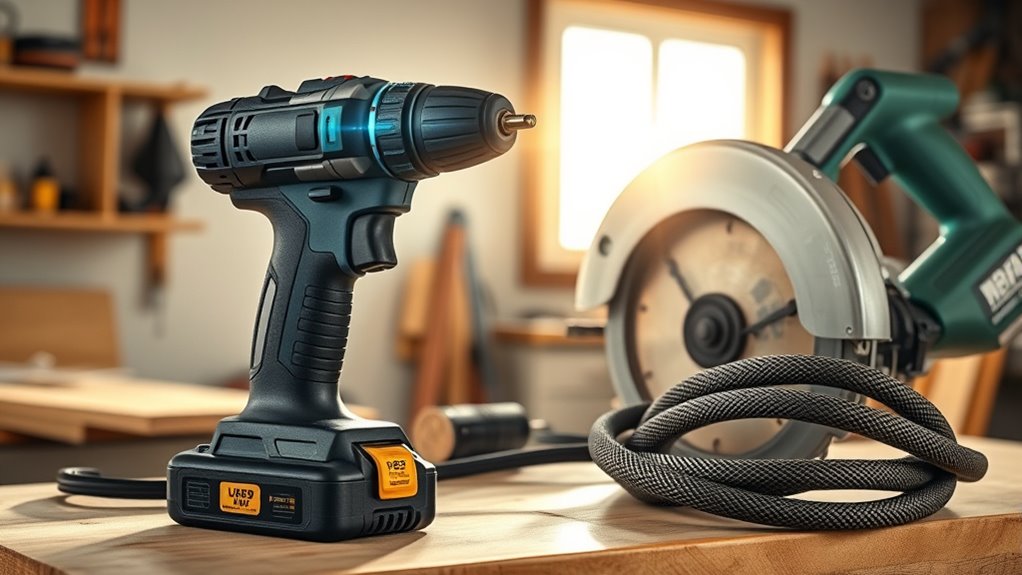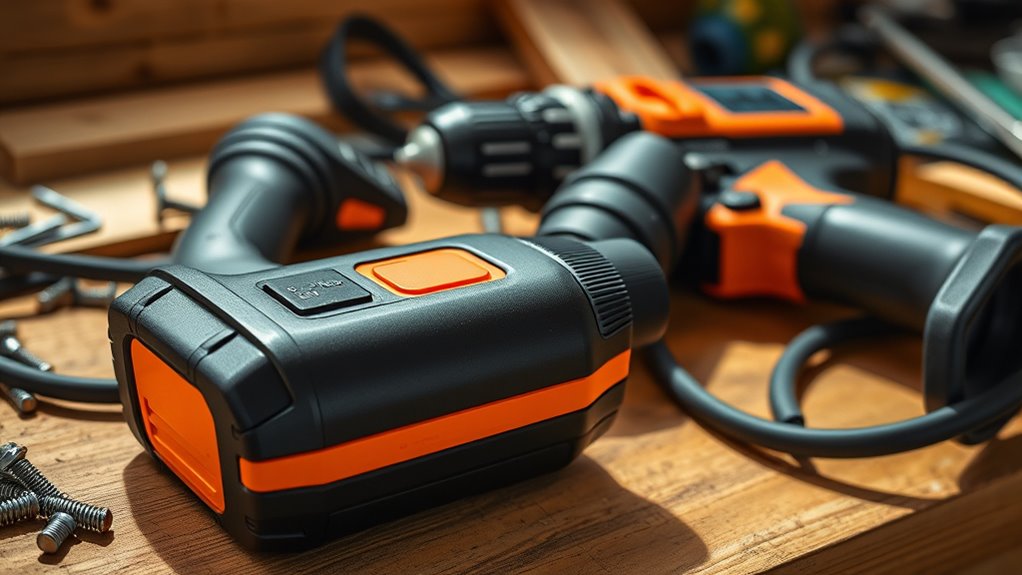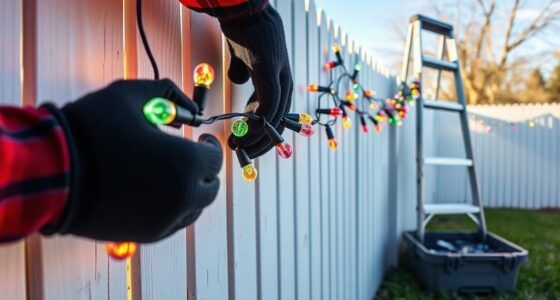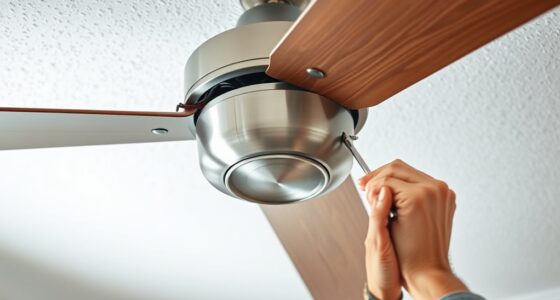Cordless tools give you freedom of movement and are great for quick jobs or tight spaces, but they come with higher upfront costs and limited battery life. Corded tools provide steady power for heavy-duty tasks and are usually cheaper initially, but you’re limited by cords and less portable. To make the best choice for your projects, consider your needs for mobility, power, and budget—more details can help you decide which type suits you best.
Key Takeaways
- Corded tools offer consistent, high power ideal for heavy-duty tasks, while cordless tools provide portability for versatile DIY projects.
- Corded tools are less expensive upfront and require minimal maintenance, unlike cordless models that depend on costly batteries.
- Corded tools require an outlet, limiting mobility, whereas cordless tools allow free movement in tight spaces and outdoor areas.
- Battery life in cordless tools can decline over time, leading to increased long-term costs and potential performance issues.
- Choose corded for continuous, demanding work; select cordless for convenience, quick setups, and mobility in home DIY projects.

When choosing between cordless and corded tools, understanding their key differences can help you make the right decision for your projects. Corded tools typically provide higher power output because they draw energy directly from a power source, making them ideal for heavy-duty tasks. They tend to be more consistent in performance since they aren’t limited by battery life, which means you can rely on them for prolonged use without concern about losing power midway. However, their performance can vary if the power supply fluctuates, and they often require a dedicated outlet, limiting your mobility. If you’re working on a large project or in a workshop with accessible outlets, corded tools can be a reliable choice.
Corded tools deliver reliable, high power for heavy-duty tasks but limit mobility.
Cordless tools, on the other hand, are generally less powerful but perfectly capable for most DIY projects around the house. They draw energy from batteries, which means your work isn’t restricted by cords or outlet locations. This makes them especially convenient for tasks in tight or outdoor spaces, where power outlets might not be nearby. Their portability allows you to move freely from one spot to another, and their compact design makes storage much easier. Still, performance can sometimes be inconsistent, especially if the battery charge drops or if the battery itself begins to degrade over time. For frequent use or larger projects, you may need to keep spare batteries handy or replace old ones, which adds to your costs.
Cost is another factor to weigh. Corded tools generally cost less upfront because they don’t require batteries, making them more budget-friendly for occasional use. Conversely, cordless tools can be more expensive initially, as you might need to purchase batteries separately, and replacement batteries can add to the long-term cost. Batteries have a limited lifespan, and once they wear out, replacing them can be costly. Additionally, some cordless models are sold without batteries, which can further increase the overall expense if you need to buy batteries separately.
Durability and maintenance also differ. Corded tools tend to last longer because they have fewer moving parts and don’t rely on batteries that can degrade over time. They require less maintenance overall, aside from occasional care of cords to prevent damage. Cordless tools, however, require regular battery maintenance, including proper charging and storage, to keep them running efficiently. Batteries need to be kept healthy, and their performance can decline if not properly cared for. Both types of tools benefit from good maintenance practices, which can extend their lifespan and ensure they’re ready when you need them.
Ultimately, your choice depends on the type of projects you undertake. Cordless tools offer unmatched versatility and mobility for most home DIY tasks, while corded tools provide consistent power and durability for more demanding, heavy-duty work.
Frequently Asked Questions
How Do Cordless Tools Compare in Weight to Corded Ones?
You’ll find cordless tools generally weigh more than corded ones because of their batteries. The added weight varies depending on battery size and tool design, but it can make cordless options feel heavier during extended use. While some cordless tools are balanced for better handling, the extra weight from batteries might cause fatigue. Ultimately, if you prefer lighter tools for prolonged tasks, corded options might be more comfortable for you.
Are Cordless Tools More Expensive Than Corded Options?
You might notice cordless tools tend to be more expensive than corded options upfront. This is because they include batteries and chargers, which add to the cost. While corded tools are generally cheaper initially and provide consistent power, cordless options offer greater mobility and convenience, making them a worthwhile investment. Keep in mind, long-term costs for cordless tools can add up due to battery replacements over time.
What Is the Typical Lifespan of Cordless Batteries?
Did you know lithium-ion batteries usually last between 2 to 5 years? When you ask about the typical lifespan of cordless batteries, it depends on usage, storage, and maintenance. Heavy use accelerates wear, while proper care can extend their lifespan. To get the most out of your batteries, avoid extreme temperatures, overcharging, and store them in cool, dry places. With good habits, you can maximize their longevity.
Can Cordless Tools Perform as Well as Corded During Heavy-Duty Tasks?
You wonder if cordless tools can match corded ones for heavy-duty tasks. While cordless tools have improved with better batteries and brushless motors, they still may not deliver the same consistent power and torque as corded models, especially during prolonged, demanding work. However, if mobility and convenience are your priorities, high-capacity cordless tools can perform quite well, but for continuous heavy-duty use, corded tools often remain the better choice.
How Do Maintenance Requirements Differ Between Cordless and Corded Tools?
Think of your tools as trusted partners, each with their own needs. When it comes to maintenance, cordless tools demand regular battery care, avoiding deep discharges, and replacing batteries over time. Cords in corded tools need frequent inspections for wear and tear. You’ll also monitor heat buildup and electrical connections. While cordless tools require more ongoing attention, corded ones mainly need cord and electrical checks, making maintenance a different, yet essential, part of your DIY journey.
Conclusion
Choosing between cordless and corded tools is like deciding whether to carry a lantern or plug into a steady fire. Cordless offers freedom and mobility, shining brightly wherever you go, while corded provides unwavering power, like a steady flame that never flickers. It’s up to you to select the tool that best lights your way on your DIY journey, ensuring your projects are completed with confidence and clarity, no matter the path ahead.










